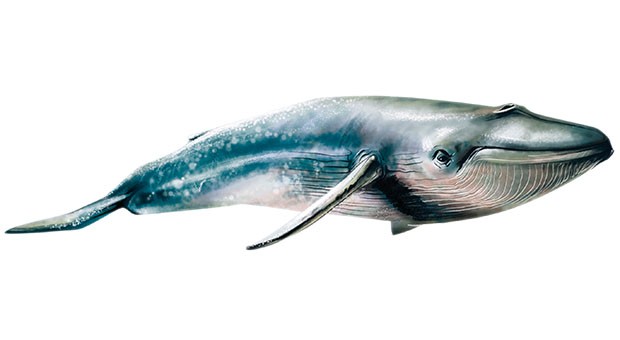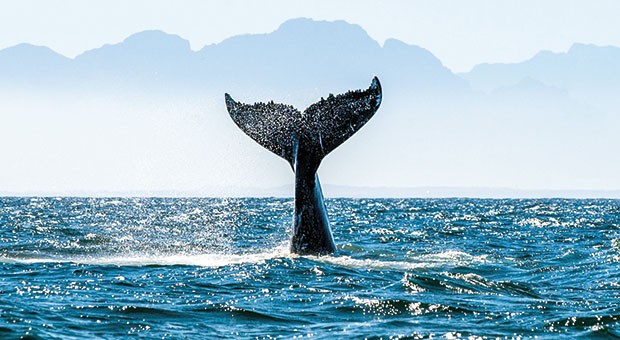A causa della caccia dei balenieri, i giganti blu degli oceani si sono ridotti del 99%
Nel luglio del 2018 i balenieri islandesi hanno arpionato uno degli ultimi esemplari viventi di balenottera azzurra, uccidendolo per farne carne in scatola, gelatine e integratori.
Denunciato dall'organizzazione Sea Sheperd, l'episodio – che non si verificava da oltre quarant'anni – ha generato grande scalpore: la specie, infatti, è rigorosamente protetta dalle leggi internazionali, vicina all'estinzione proprio a causa delle mattanze di cetacei che hanno ridotto il numero di esemplari del 99%.
La compagnia islandese si è difesa sostenendo che la balena uccisa somigliasse più a una balenottera comune – per cui aveva il permesso di caccia – che a una balenottera azzurra, o che fosse probabilmente un ibrido tra le due. Gli esperti hanno per lo più smentito, dichiarando che l'animale era perfettamente riconoscibile, soprattutto da un equipaggio esperto.
Il gigante blu del mare
La balenottera azzurra (Balaenoptera musculus), che appartiene alla famiglia dei balenotteridi, è il più grande animale conosciuto mai vissuto sulla terra con i suoi oltre 33 metri di lunghezza e le sue 150 tonnellate di peso. Perché sia chiara l'entità della sua mole, si pensi che pesa più di 30 elefanti, di 3 dei più grossi dinosauri mai esistiti e che il suo cuore pesa 550 chili, il fegato una tonnellata, la lingua 350 chili. Il corpo della balenottera è lungo e slanciato e può assumere varie tonalità di grigio e blu sul dorso, per farsi più chiaro sul ventre; per questo spesso viene appellata col nome di “gigante blu”.
La testa è appiattita e a U, e presenta una cresta che va dallo sfiatatoio alla cima del labbro superiore. Facendo capo al sottordine dei misticeti, la balenottera non ha dei veri denti, bensì i cosiddetti fanoni, ovvero delle lamine usate come filtro per espellere l'acqua e trattenere i piccoli animali di cui si nutrono.
Nel suo caso, i fanoni sono circa trecento e lunghi circa un metro ciascuna, posizionati nella parte anteriore della bocca. La pinna dorsale è piccola, tant'è che diventa visibile solo nel momento dell'immersione, mentre quelle pettorali sono lunghe circa quattro metri, grigie da un lato e bianche dall'altro.
La capacità dei suoi polmoni è di ben 5000 litri; possiede due sfiatatoi gemelli protetti da una sorta di paraschizzi e quando respira emette un soffio verticale di quasi dieci metri. Il gigante blu nuota generalmente da solo, al massimo in coppia, a una velocità di circa venti chilometri orari, ma può raggiungere anche i cinquanta; quando si nutrono, invece, si spostano molto lentamente, a una velocità che di solito non supera i cinque chilometri orari.
Uno dei misteri più grandi che riguarda questa specie è quello che riguarda il loro canto; molti, infatti, sono gli studiosi che si sono dedicati a questo linguaggio: le balenottere azzurre emettono richiami ad un frequenza di 10-40 Hz, assai difficili da percepire per l'uomo, ma le ragioni per cui lo facciano sono ancora ignote.
Si ipotizzano varie spiegazioni, tra cui la necessità di localizzare punti topografici o fonti di cibo, mantenere la distanza tra i vari individui e ancora attirare il sesso opposto.
Fino agli inizi del XX secolo la balenottera azzurra era cospicuamente presente in tutti gli oceani; la caccia indiscriminata dei balenieri l'ha ridotta quasi all'estinzione e solo nel 1966 la comunità internazionale l'ha dichiarata specie protetta.
Oggi rimangono popolazioni molto piccole di circa 2000 individui (contro i 250000 originari), concentrate nel Pacifico e negli Oceani Australe e Indiano.
Per questo, seppur in netto ritardo, è importante assicurarsi che episodi come quello islandese non accadono mai più.
Laura Spataro

 The blue whale, the largest animal in the world, on the verge of extinction
The blue whale, the largest animal in the world, on the verge of extinction
As a result of whale hunters, numbers of these blue ocean giants are down 99%
In July 2018 Icelandish whale hunters harpooned one of the last living examples of blue whale, killing it to make tinned meat, gelatine and dietary supplements out of it. Reported by the organisation Sea Shepherd, the episode - the first time in over forty years - shocked the world. The species is strictly protected in international law and on the verge of extinction thanks, precisely, to a whale slaughter which has decimated numbers by 99%. The Icelandish company responsible defended itself by saying that the whale killed looked more like a common whale - which it had permission to hunt - than a blue whale and was probably a hybrid. The experts denied it, declaring that the whale was entirely recognisable, above all to an expert team.
The blue giant of the seas
The blue whale (Balaenoptera musculus), belonging to the Balaenopteridae family, is the largest known animal ever to have lived with its over 33 metres of length and 150 tons in weight. To give you an idea of what this means, note that it weighs more than 30 elephants, 3 of the largest dinosaurs which ever existed and that its heart weights 550 kilos, its liver a ton and its tongue 350 kilos.
The whale’s body is long and tapered in shape and ranges in colour from grey to blue on its back, turning paler on its belly. This is why it is called the ‘blue giant’. Its head is flattened into a U shape and it has a crest stretching from its blowhole to the top of its upper lip. Part of the sub-family of the Mysticeti, the whale does not have real teeth but rather so-called baleen plates, i.e. blades used as filters to expel water and keep the small animals it feeds off in. In the case of the blue whale there are around three hundred of these plates, each around one meter long and positioned at the front of its mouth. Its dorsal fin is small and only visible when it dives while its pectoral fins are around four metres long, grey on one side and white on the other.
Its lung capacity is a grand total of 5000 litres and it has two twin blowholes protected by a sort of spray guard. When it breathes it emits a vertical jet almost ten metres high. The blue giant generally swims alone or at most in pairs, at a speed of around 20 kilometres per hour but it can reach speeds of 50. When it feeds it moves very slowly, generally at speeds of less than 5 kilometres per hour. One of the greatest mysteries around the species relates to its song. Many scholars have studied this language. Blue whales sing at frequencies of 10-40 Hz, a frequency which is extremely difficult for humans to hear, but the reasons for it are still unknown.
Many theories have been put forward including the need to locate topographical locations or sources of food, maintain distances between individuals or attract the opposite sex. Until the early 20th century blue whales were conspicuously present across the oceans but indiscriminate hunting has reduced them to the point of extinction and it was only in 1966 that the international community declared it a protected species. Today populations are very small with around 2000 individuals (as compared to an original figure of 250,000) concentrated in the Pacific and the Austral and Indian oceans. For this reason, however late in the day, it is vital to ensure that episodes like that in Iceland never happen again.
TRADUZIONE A CURA DI VICEVERSA GROUP:
Bergamo – Zona Stadio
Per informazioni Tel: 035 4281462
Traduzioni e Interpretariati professionali
Staff multilingue per fiere, congressi, eventi
Corsi di lingue per privati e aziende
















